
La Cour-Dieu Abbey (French : Abbaye de La Cour-Dieu; Latin : Curia Dei) is a former Cistercian monastery in the commune of Ingrannes in Loiret, France, situated about 19 km south of Pithiviers.

La Cour-Dieu Abbey (French : Abbaye de La Cour-Dieu; Latin : Curia Dei) is a former Cistercian monastery in the commune of Ingrannes in Loiret, France, situated about 19 km south of Pithiviers.
La Cour-Dieu, the sixth daughter house of Cîteaux, was founded in 1119. It developed rapidly and was very soon able to undertake the foundation of its own daughter houses: Lorroy (1125), Le Val (1136), Olivet (1145), Iranzu in Navarre (1178) and Cercanceaux (1181). It possessed many granges, including that at Chérupeau in Tigny. Construction of the church began in 1170 and was completed in 1216.
The abbey was partially destroyed in 1399. In 1562 and 1567 it was besieged by Protestants during the Wars of Religion.
During the French Revolution in 1791 it was dissolved and abandoned.
The Gothic church fell into ruin after the Revolution. A portion survives of the very simple west front, flanked by a 15th-century five-sided tower containing a spiral staircase, and the northern transept. The former abbot's residence, built in 1720, is now a private house. Of the conventual buildings, also now used for residential purposes, there survive the chapter house and the kitchen, with a central hearth of the 13th century. Nothing remains of the cloister. The choir stalls are now in the church of Jargeau.
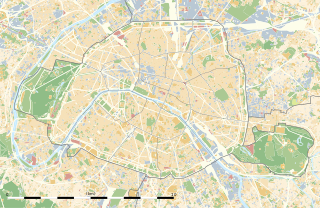
The Île de la Cité is an island in the river Seine in the center of Paris. In the 4th century, it was the site of the fortress of the Roman governor. In 508 Clovis I, the first King of the Franks, established his palace on the island. In the 12th century it became an important religious center, the home of Notre-Dame cathedral, and the royal chapel of Sainte-Chapelle, as well as the city's first hospital: the Hôtel-Dieu. It is also the site of the city's oldest surviving bridge, the Pont Neuf.

Altorf is a commune in the Bas-Rhin department in the Grand Est region of northeastern France.

Morimond Abbey is a religious complex in Parnoy-en-Bassigny, Haute-Marne department, in the Champagne-Ardenne region of France. It was the fourth of the four great daughter abbeys of Cîteaux Abbey, of primary importance in the spread of the Cistercian Order, along with La Ferté to the south, Pontigny to the west and Clairvaux to the north.

The Abbey of Sainte-Trinité, better known as the Abbaye aux Dames, is a former nunnery in Caen, Normandy, now home to the Regional Council of Normandy. The complex includes the Church of Sainte-Trinité.

La Cambre Abbey or Ter Kameren Abbey is a former Cistercian abbey in the City of Brussels (Belgium). It is located in the Maelbeek valley between the Bois de la Cambre/Ter Kamerenbos and the Ixelles Ponds. The abbey church is a Catholic parish of the Archdiocese of Mechelen-Brussels and home to a community of Norbertine canons, while other parts of the monastery house the headquarters of the Belgian National Geographic Institute and La Cambre, a prestigious visual arts school.

Rue Saint-Denis is one of the oldest streets in Paris. Its route was first laid out in the 1st century by the Romans, and then extended to the north in the Middle Ages. From the Middle Ages to the present day, the street has been notorious as a place of prostitution. Its name derives from it being the historic route to Saint-Denis.

The Abbey of St Genevieve (Abbaye-Sainte-Geneviève) was a monastery in Paris. Reportedly built by Clovis, King of the Franks in 502, it became a centre of religious scholarship in the Middle Ages. It was suppressed at the time of the French Revolution.

Neubourg Abbey is a former Cistercian monastery in Alsace, France, in Dauendorf, about 9 km west of Haguenau in the Bas-Rhin department.

Preuilly Abbey was a Cistercian monastery in Égligny in the Seine-et-Marne department, France. It was located about 21 kilometres south-west of Provins and 15 kilometres east of Montereau-Fault-Yonne.

The Manoir de Mézarnou is a fortified 16th century manor-house located in the Finistère département of Brittany in northwestern France. It is located in the small rural town of Plounéventer, near Landivisiau. It was erected by Yves de Parcevaux, who reorganised the domaine between 1571 and 1591.
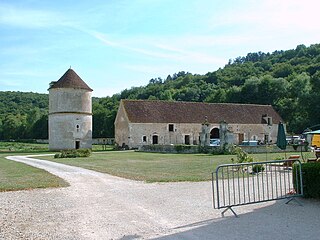
Reigny Abbey was a Cistercian monastery in Vermenton, department of Yonne, Bourgogne, France.
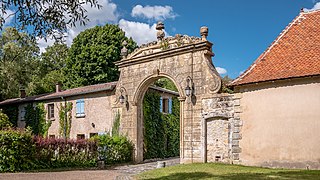
Villers-Bettnach Abbey is a former Cistercian abbey in the commune of Saint-Hubert in the Moselle department, France. The monastery site is about 22 kilometres north-east of Metz, in the valley of the little River Canner, and was classed as a monument historique on 28 March 1905.
Les Feuillants Abbey, also Feuillant Abbey, was a Cistercian monastery located in the present commune of Labastide-Clermont, about 8 kilometres south of Rieumes, department of Haute-Garonne, France. From the 16th century it was the centre of the Cistercian reform movement to which it gave its name, the Feuillants.

Igny Abbey or Val d'Igny Abbey is a Cistercian abbey located in Arcis-le-Ponsart, Marne, France. It was founded in 1128 for Cistercian monks, dissolved in 1791 during the French Revolution, re-established in 1876 for Trappist monks, destroyed in 1918, reopened in 1929 for Trappist nuns and modernised in 2008–12 to accommodate three or four pre-existing communities.

Montiéramey Abbey is a former Benedictine abbey at Montiéramey, in France, in the department of Aube, in France. It was partly destroyed during the French Revolution; the surviving buildings are now private dwellings.

The Priory of Saint-Martin-des-Champs was an influential monastery established in what is now the city of Paris, France. Its surviving buildings are considered treasures of Medieval architecture in the city.
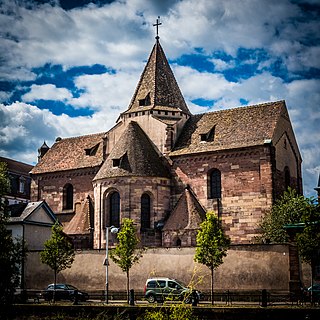
Saint Stephen’s Church in Strasbourg is located inside the catholic ‘Saint-Étienne’ college in Strasbourg, for which it serves as a chapel.

Abbey of Saint-Pierre de la Couture was a Benedictine monastery in Le Mans. All that survives of it is the abbey church and some of the abbey buildings; the latter date to a rebuild between 1760 and 1775 and are now used to house the prefecture for Sarthe. Dating to the 11th century, the monastery was considered one of the most powerful in western France before the French Revolution.
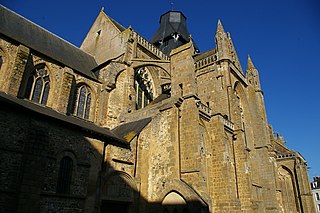
Évron Abbey is a former Benedictine abbey in Évron, in the Mayenne department in France. Its foundation is ascribed to the 7th century. It was dissolved in 1791 during the French Revolution. The former monastic church survived intact, and is now the Basilica of Notre-Dame de l'Épine.

La Crête Abbey was a Cistercian monastery in the commune of Bourdons-sur-Rognon in the département of Haute-Marne, France.
Coordinates: 48°00′21″N2°11′50″E / 48.00583°N 2.19722°E